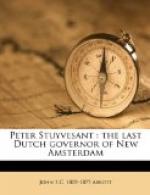One of these patroons, Kiliaen Van Rensselaer, a wealthy merchant in Holland, who had been accustomed to polish pearls and diamonds, became, as patroon, possessed of nearly the whole of the present counties of Albany and Rensselaer, in the State cf New York, embracing the vast area of one thousand one hundred and forty-one square miles. Soon all the important points on the Hudson River and the Delaware were thus caught up by these patroons, wealthy merchants of the West India Company.
When the news of these transactions reached Holland, great dissatisfaction was felt by the less fortunate shareholders, that individuals had grasped such a vast extent of territory. It was supposed that Director Minuit was too much in sympathy with the patroons, who were becoming very powerful, and he was recalled. All were compelled to admit that during his administration the condition of the colony had been prosperous. The whole of Manhattan Island had been honestly purchased of the Indians. Industry had flourished. Friendly relations were everywhere maintained with the natives. The northwestern shores of Long Island were studded with the log cottages of the settlers. During his directorship the exports of the colony had trebled, amounting, in the year 1632, to nearly fifty thousand dollars.
We come now to a scene of war, blood and woe, for which the Dutch were not at all accountable. It will be remembered that a colony had been established near the mouth of Delaware Bay. Two vessels were dispatched from Holland for this point containing a number of emigrants, a large stock of cattle, and whaling equipments, as whales abounded in the bay. The ship, called the Walvis, arrived upon the coast in April, 1631. Running along the western shore of this beautiful sheet of water, they came to a fine navigable stream, which was called Horekill, abounding with picturesque islands, with a soil of exuberant fertility, and where the waters were filled with fishes and very fine oysters. There was here also a roadstead unequalled in the whole bay for convenience and safety.
Here the emigrants built a fort and surrounded it with palisades, and a thriving Dutch colony of about thirty souls was planted. They formally named the place, which was near the present town of Lewiston, Swaanendael. A pillar was raised, surmounted by a plate of glittering tin, upon which was emblazoned the arms of Holland; and which also announced that the Dutch claimed the territory by the title of discovery, purchase and occupation.




